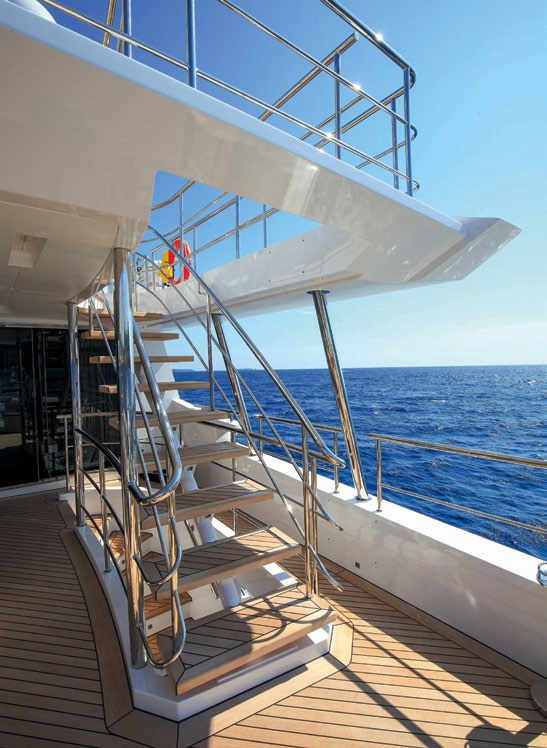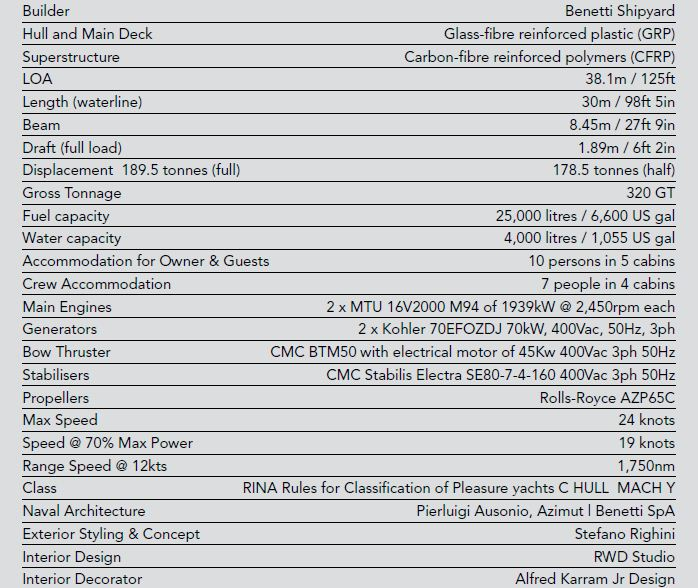Ironman is the first yacht in the groundbreaking benetti vivace 125’ series that has seen five yachts sold already.


IRONMAN IS THE FIRST YACHT IN THE GROUNDBREAKING BENETTI VIVACE 125’ SERIES THAT HAS SEEN FIVE YACHTS SOLD ALREADY.




NOMEN EST OMEN, said the ancient Romans: the name speaks for itself. And, in fact, the Benetti Vivace 125’ M/Y Ironman has a name that says much about a yacht that is way ahead of the game.
“We hadn’t intended selling hull number one in this series because there was so much new technology aboard,” says Fabio Ermetto, Benetti’s Chief Commercial Officer. “We wanted to run tests on all the systems and try out the new hull shape, but Ironman’s Owner saw the yacht and could not be moved: he wanted that yacht. So he got it.
“We are now very happy to officially celebrate this triply innovative yacht with our new D2P hull, a carbon-fibre superstructure and Carbon Azipull propulsion and this successful threeway collaboration: Benetti, the Owner and his designer Alfred Karram Jr of AKJ Design Concepts, and Rolls-Royce.”
Yes, because this Ironman drives a Rolls, or rather this Benetti Vivace 125’ yacht runs with an innovative propulsion system denoted Azipull Carbon – developed, designed and built by Rolls-Royce Marine. Ironman has two Azipull Carbon steerable thrusters. Integrating both propulsion and rudder functions, they can be commanded from a traditional helming wheel, from individual thruster tillers and from a combined joystick control lever.
“While the Rolls-Royce name is known to many as a luxury car brand, we haven’t actually built cars for many years – that’s now done by BMW,” explains Solvar N. Klokk from Rolls-Royce. “Our marine business is part of Rolls-Royce plc, a global engineering company with several divisions that produce power systems for use on land, at sea and, of course, in the air with our famous aero engines. Our vision is to provide better power for a changing world.”
The Rolls-Royce Marine business started developing pulling, steerable thrusters back in 2000. The first unit, with the product name Azipull, was delivered in 2003 and, as of today, the company has built and delivered more than 500 such units for main propulsion across a range of vessel types.
“Looking to expand our market opportunities for steerable thrusters, we considered the yacht, workboat and passenger vessel markets,” Klokk says. “All presented interesting opportunities. After studying the yachting industry, we realised that to fully utilise the opportunities of pulling, steerable thrusters, weight was an essential element along with propulsion efficiency. With our mainstream technology at the time we could not meet the weight criteria.”
Benetti has been a very cooperative partner in developing a new, lightweight carbon casing for Azipulls destined to be mounted on yachts.
“We thought hard about where we could save on weight,” continues Klokk. “We couldn’t significantly reduce the weight of the propellers or of the basic drive line, so the saving had to come from the supporting structure, casing and auxiliary systems.
“As a result, our designers selected a double carbon-fibre material for the casing with an inner shell that supports the driveline and an outer shell that gives it the correct flow line. This enables a substantial system weight reduction well in support of the market requirements. Our Azipull Carbon weighs just 2,800kg.”
The flow line is very important for the Azipull Carbon’s efficiency, as are the reduced levels of noise and vibrations. “The thruster’s casing and its integration to the vessel hull have been hydrodynamically optimised through extensive CFD (Computational Fluid Dynamics) analysis and validation testing,” says Klokk. “The unit’s wide chord provides a rudder effect and improves the yacht’s course stability, while the casing shape recovers swirl energy from the propeller and uses it as thrust.
“Of course, the flow of water into the propeller is determined by the hull shape. We worked with Benetti to design a hull that would easily incorporate our thrusters and that would secure a homogenous inflow to the thruster. That way we reduce cavitation and minimise noise and vibration.”
The Benetti Vivace 125’ D2P hull shape is another innovation. D2P stands for Displacement to Planing® and it’s really two hulls in one – at reduced speeds it’s a low-draft displacement hull ideal for navigation in shallow waters, at higher speeds it rises out of the water, skimming easily and silently along the surface. This hull shape is an excellent partner for the Azipull Carbon propulsion system.
“Just like the D2P hull shape offers the advantages of two hull shapes in one, the Azipull Carbon has two operating modes, transit mode and manoeuvring mode, depending on the vessel speed,” says Klokk.
“The steering angle is linked to speed. In high-speed transit mode, when the hull is planing, the control system will limit the angle from eight to about 20 degrees. In low-speed manoeuvring mode, you can use the full 35 degrees available. The system also has a dynamic positioning option for keeping the yacht in one place without having to drop anchor.”
Weight and speed are inversely proportional; that’s why Benetti developed a lightweight carbon-fibre superstructure for the Vivace 125’ series. “The market wants comfortable, spacious and highly efficient yachts,” says Ermetto. “The Vivace 125’s carbon fibre and epoxy resin superstructure weighs 60% less that a similar structure in fibreglass, which makes for a more energy-efficient yacht.”
Boarding Ironman is a visual experience where stone, steel, leather and glass work together to dramatic effect.
“The interior design concept for Ironman was for a one of a kind space with a highly innovative modern aesthetic,” says interior designer Alfred Karram Jr. “I was impressed by the newness of this project, by being given the chance to design something the likes of which had never been seen before. I was attracted by the idea that this yacht was a prototype, because my design for it was breakaway.
“Ironman was my first yacht, and I didn’t approach it any differently than I would have if it had been a home, apartment or hotel. The client wanted strong, dynamic spaces for a modern, high tech lifestyle. Using the angle of the bow as a starting point, I created sharp, dramatic geometries and used luxurious and state of the art materials like book matched, vein matched granite, textured aluminium, glass and steel add to the feeling of machinelike strength and technology. All furnishings aboard Ironman are modern and angular, with a predominant grey, black and white tones set off by red accents.
“I will never forget the first time the Owners boarded the completed yacht: the Owner’s wife kept her hand over her mouth and was looking more and more surprised each space we walked through. The main saloon, the Owner’s suite, then on to the lower deck to see the VIPs and the twin cabins. The hand never came down from in front of her mouth. I was getting a little nervous: was there a smile under there or what?
“I walked back up the retro illuminated staircase and heard her husband say, ‘just tell him, go ahead and tell him.’ She came back up and burst out crying when she saw me. My heart sank, but then she said, ‘there has never been anyone who has understood my husband better than you have, thank you for creating this beautiful yacht!’
‘My working relationship with Benetti was also very special and I think that we complimented each other in ways that surprised us all. I created an interior that was just as innovative as their building technology was, it was a natural fit.”
Before the tour of the interior is over, the yacht has been put into gear and is leaving the port. I only notice the scenery changing – the engines are so silent. Once out of port I think we are just cruising along until I see the wake churning behind us: we are in planing mode at 22 knots and the yacht is just purring.
Captain Ricardo Fernandez takes Ironman through a series of tight turns to show the manoeuvring angle, but the yacht barely heels thanks to the compensating action of the twin Azipulls.
There can be no doubt about it: the Benetti Vivace 125’ M/Y Ironman is certainly the result of the union of forward-thinking minds. www.benettiyachts.it






































